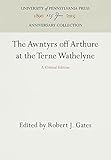The Awntyrs off Arthure at the Terne Wathelyne : A Critical Edition / Robert J. Gates.
Material type: TextSeries: Haney Foundation SeriesPublisher: Philadelphia : University of Pennsylvania Press, [2016]Copyright date: ©1969Edition: Reprint 2016Description: 1 online resource (268 p.)Content type:
TextSeries: Haney Foundation SeriesPublisher: Philadelphia : University of Pennsylvania Press, [2016]Copyright date: ©1969Edition: Reprint 2016Description: 1 online resource (268 p.)Content type: - 9780812275872
- 9781512802344
- 821.1 22
- PR2065.A8
- online - DeGruyter
| Item type | Current library | Call number | URL | Status | Notes | Barcode | |
|---|---|---|---|---|---|---|---|
 eBook
eBook
|
Biblioteca "Angelicum" Pont. Univ. S.Tommaso d'Aquino Nuvola online | online - DeGruyter (Browse shelf(Opens below)) | Online access | Not for loan (Accesso limitato) | Accesso per gli utenti autorizzati / Access for authorized users | (dgr)9781512802344 |
Frontmatter -- Preface -- Contents -- List of Abbreviations -- 1. Manuscripts -- 2. Previous Editions -- 3. Sources and Analogues -- 4. Dialect -- 5. Authorship -- 6. Date -- 1. The Editorial Problem -- 2. Comparison of Variants -- 3. Manuscript Relations -- 4. Editorial Methods -- Select Bibliography -- The Awntyrs off Arthure at the Terne Wathelyne -- Critical Notes -- Glossary and Index of Proper Names -- Index of Proper Names
restricted access online access with authorization star
http://purl.org/coar/access_right/c_16ec
This anonymous Middle English poem of the late fourteenth century, a central work in the Arthurian group, is an important example of the tradition known as the "alliterative revival" and is one of a group of poems having Sir Gawain as hero. Its metrical form is the most intricate in Middle English Romance, including rhyme, alliteration, and stanza-linking. The stanza consists of nine long alliterative lines rhyming ababababc and a "wheel" of four shorter lines rhyming dddc. In this first critical edition based on all four extant manuscripts, Robert J. Gates has contributed careful commentary with extensive critical apparatus. He attempts to reconstruct original readings that have been lost in one or more of the manuscripts. His glossary, however, uses words from the variant readings as well as those accepted in the edited text. Using the editorial methods developed by George Kane in his edition of Piers Plowman, Gates gives abundant new evidence of the usefulness of these methods. He believes that the edition shows that written poems could be formulaic and that scribes often substituted readings consisting of formulaic whole or half lines.
Mode of access: Internet via World Wide Web.
In English.
Description based on online resource; title from PDF title page (publisher's Web site, viewed 23. Jul 2020)


